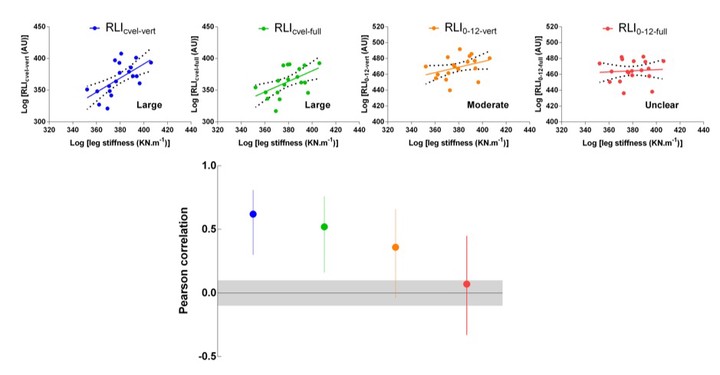Convergent validity, reliability and sensitivity of a running test to monitor neuromuscular fatigue
 Validity analysis. Upper panel represents the linear relationship between leg stiffness and the different Running Load Index. Lower panel represents the Pearson correlation between leg stiffness and the different Running Load Index.
Validity analysis. Upper panel represents the linear relationship between leg stiffness and the different Running Load Index. Lower panel represents the Pearson correlation between leg stiffness and the different Running Load Index.
Abstract
Constraints inherent to team sport environments make fatigue monitoring challenging. Micro technology and embedded accelerometers may provide more practical methods of fatigue monitoring within team sports through the use of standardized running tests. However, metrics gathered from these tests have yet to be related to an established biomechanical variable such as leg stiffness. The aim of this research is therefore to provide information on the convergent validity, reliability and sensitivity of the approach in the context of team sport. Twenty male rugby union players (age 21.0 ± 1.3 years; height 185.2 ± 6.1 cm; body mass 97.3 ± 10.3 kg) were recruited for the study, which took place during their preseason. The standardized running test consisted of four 60 meter runs paced at ≈5m•s-1 with 33 seconds of recovery between trials. GPS and accelerometer data were used to calculate a running load index which was a ratio between the mechanical load and the speed performed during each runs. A submaximal double hopping leg test to determine leg stiffness was use to assess the convergent validity of the running load index. The reliability was assessed by repeating twice the same procedure over two weeks. The sensitivity to fatigue was assessed between the beginning and the end of a typical week of training. Large relationships between leg stiffness and running load index were found (r ranged from 0.52 to 0.60). Regarding the reliability, small to moderate standardized typical errors were found. The sensitivity analysis showed the leg stiffness presented a very likely trivial change over the course of one week of training, while running load index showed very likely small to a most likely large changes. This study provided a first insight how such standardized running test could be used in practice to monitor neuromuscular fatigue.